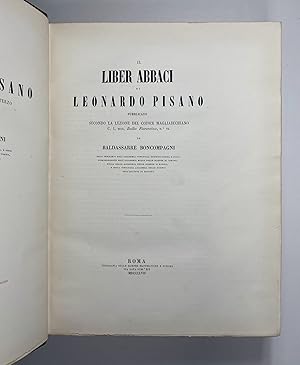About this Item
2 vols., folio. Numerous diagrams; occasional light spotting and foxing. Modern brown morocco, uncut. In slipcases. EDITIO PRINCEPS OF THE WRITINGS OF FIBONACCI, THE GREATEST MATHEMATICIAN OF THE MIDDLE AGES, STILL THE ONLY COMPLETE EDITION PUBLISHED. IN THE HISTORY OF MATHEMATICS THIS UNABRIDGED EDITION OF THE LATIN TEXT IS ESSENTIAL, AND WAS THE VEHICLE BY WHICH FIBONACCI'S WORKS WERE DISSEMINATED THROUGHOUT MODERN AND CONTEMPORARY CULTURE. Rare in private ownership. Sold at Sotheby's forty years ago, ours is ONLY copy that has ever appeared at public auction according to Rare Book Hub, which currently lists more than 14 million records in the Rare Book Transactions database; furthermore, it is the only copy currently available on the market. Leonardo of Pisa (ca. 1170-1250), a.k.a. Fibonacci, is justly considered to be the most important mathematician of the Middle Ages, if only for being the first Christian mathematician to systematically explain Arabic numerals. Indeed, the mathematical renaissance in the West began with him according to George Sarton. The first volume contains the the 'Liber Abaci,' devoted to problems of computation including algebraic quadratic problems; here Fibonnaci here introduces Arabic numerals, the fraction bar, and the numerical approach to square roots and cube roots. The second volume contains the 'Practica Geometriae,' devoted to the application of algebra to geometric problems; 'Flos,' written for Frederick II in answer to a number of mathematical problems posed by Magister Johannes; "Letter to Magister Theodorus" developing a general method for the solution of indeterminate problems; and finally the great "Liber quadratorum," described by Vogel as "a first-rate scientific achievement and showing Fibonacci as "a major number theorist." Vogel continues to assert (correctly) that Fibonacci was far ahead of his time, without a successor until 1621, when Bachet made the text of Diophantus available which in turn stimulated Fermat in founding number theory. "In addition to the antique manuscripts, there also undeniably exists, however, a vehicle that, notwithstanding the inadequate and problematic access to the manuscript sources, has spread the text of the Fibonaccian treatise throughout modern and contemporary culture: the well known Italian mathematician and historian of science Baldassarre Boncompagni Ludovisi, in fact, in his brilliant far-reaching project which brought into focus the personality of Fibonacci, as well as his surviving works, realized and published in Rome in 1857 [i.e. THIS EDITION] what can with ample justification be defined the editio princeps of the entire treatise." (Germano). Despite the flaws in Boncompagni's work, "it of course was a noteworthy editorial operation, especially as it made available in print to a vast number of interested parties a work which had almost fallen into oblivion and that up to that time could be consulted only from its manuscript sources, with all the difficulties and inconvenience which this could entail." (Germano). It is fair to say that Fibonacci's contributions to mathematics languished unappreciated until the rediscovery of his texts and their presentation in the present -- surprisingly rare -- volumes. Despite its flaws, Boncompagni's edition serves as the basis for only complete translation of the Liber Abici made into a modern language thus far, namely Lawrence E. Sigler's "Fibonacci s Liber Abaci. A Translation into Modern English of Leonardo Pisano s Book of Calculation" (2002). Whereas Sigler corrected some errors he introduced many others, usually on account of inability to understand and effectively translate the Renaissance Latin text. Before Boncompagni's edition, only the "Prologus" and Chapter XV of Fibonacci's Liber Abaci had received a respectful circulation in print that was due to G. Libri's "Histoire des sciences mathématiques en Italie, dépuis la renaissance des lettres, jusqu à la fin du dixseptième siècle" (Paris,
Seller Inventory # 4120
Contact seller
Report this item




